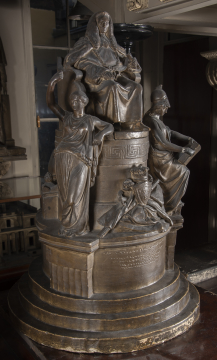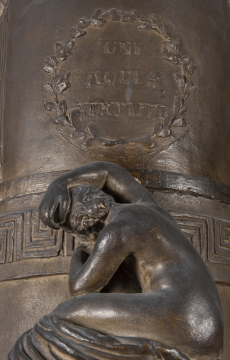Explore Collections


You are here:
CollectionsOnline
/
Model for the monument to William Murray (1705-1793), first Earl of Mansfield
Browse
SM M1163. ©Sir John Soane's Museum, London. Photo: Art UK
John Flaxman RA (1755 - 1826), sculptor
Model for the monument to William Murray (1705-1793), first Earl of Mansfield
Plaster
Height: 90cm
Width: 60cm
Depth: 60cm
Width: 60cm
Depth: 60cm
Museum number: M1163
On display: Colonnade - central aisle
All spaces are in No. 13 Lincoln's Inn Fields unless identified as in No. 12, Soane's first house.
For tours https://www.soane.org/your-visit
Curatorial note
William Murray (1705-1793), first Earl of Mansfield, had an illustrious legal career culminating in his appointment as Lord Chief Justice from 1756 to 1788. His pioneering judgement in the Somerset case in 1772 (James Somerset, a former slave, was clapped in irons by his former master and set to be shipped out to be sold in Jamaica) held that English Law did not recognise the state of slavery. This restricted slavery in Britain at a time when owning an African slave was the height of fashion in London. His tolerance towards Roman Catholics led an anti-Catholic mob to burn down his town house in Bloomsbury Square during the Gordon Riots of 1780 – he and Lady Mansfield barely escaped with their lives. When Mansfield died he was buried in the north transept of Westminster Abbey. His standing was reflected in the commissioning of a marble memorial from the neo-classical sculptor, John Flaxman, installed in 1801 between pillars and set against the Gothic windows of the Abbey.
In this small-scale model for the memorial, which Soane placed in its present position, Flaxman’s skill as a modeller is immediately obvious. The final monument, in white marble, would have been executed by assistants under his direction. The design is highly unusual in being free-standing rather than a wall monument which was the original intention – indeed, it was the first monument in an English church in the form of a free-standing group. Flaxman received the commission while in Italy and was able to study papal tombs in Rome by sculptors like Bernini while working on his design. Lord Mansfield is depicted enthroned in judicial robes, flanked by the figures of Justice holding her scales and wearing a helmet and Wisdom holding the book of law. At the back of the monument is a seated youth representing Death. The monument was moved from its original position in the Abbey in 1933 and today stands surrounded by other monuments in a setting where it is difficult to appreciate it fully.
Lord Mansfield lived at No. 56 Lincoln's Inn Fields between 1740 and 1756 when he moved to Bloomsbury Square. He purchased Kenwood House, a country estate in Hampstead, in 1754 and employed the Adam brothers as his architects (their drawings for Kenwood are amongst the Adam drawings at Sir John Soane's Museum). Lord Mansfield returned to Lincoln's Inn Fields (Nos. 57 and 58) from 1786 (although from 1788 he lived mainly at Kenwood) until his death in 1793, the year after Soane purchased 12 Lincoln's Inn Fields.
In this small-scale model for the memorial, which Soane placed in its present position, Flaxman’s skill as a modeller is immediately obvious. The final monument, in white marble, would have been executed by assistants under his direction. The design is highly unusual in being free-standing rather than a wall monument which was the original intention – indeed, it was the first monument in an English church in the form of a free-standing group. Flaxman received the commission while in Italy and was able to study papal tombs in Rome by sculptors like Bernini while working on his design. Lord Mansfield is depicted enthroned in judicial robes, flanked by the figures of Justice holding her scales and wearing a helmet and Wisdom holding the book of law. At the back of the monument is a seated youth representing Death. The monument was moved from its original position in the Abbey in 1933 and today stands surrounded by other monuments in a setting where it is difficult to appreciate it fully.
Lord Mansfield lived at No. 56 Lincoln's Inn Fields between 1740 and 1756 when he moved to Bloomsbury Square. He purchased Kenwood House, a country estate in Hampstead, in 1754 and employed the Adam brothers as his architects (their drawings for Kenwood are amongst the Adam drawings at Sir John Soane's Museum). Lord Mansfield returned to Lincoln's Inn Fields (Nos. 57 and 58) from 1786 (although from 1788 he lived mainly at Kenwood) until his death in 1793, the year after Soane purchased 12 Lincoln's Inn Fields.
Literature
Susan Jenkins, 'John Flaxman’s funerary monument for the 1st Earl of Mansfield in Westminster Abbey', The Burlington Magazine, April 2020, pp.277-287, fig.11.
V. Coltman, ‘Commission by correspondence: John Flaxman’s monument to William Murray, 1st Earl of Mansfield’, Church Monuments 22, 2007, pp.96–110, at p.102
Helen Dorey ‘Soane and Flaxman’ in Flaxman: Master of the Purest Line, Exhibition Catalogue, Sir John Soane’s Museum 2003
I. Roscoe, ed., A Biographical Dictionary of Sculptors in Britain 1660–1851, 2009, pp.443–50
D. Irwin: John Flaxman 1755–1826, London 1979, p.60,.113, 116 and 123
Margaret Whinney, ‘Flaxman and the eighteenth century’, Journal of the Warburg and Courtauld Institutes 19, no.3/4 (1956), pp.269–82, at p.279
Streets of St Giles, Camden History Society, 2012, p.120 [on Lincoln's Inn Fields]
V. Coltman, ‘Commission by correspondence: John Flaxman’s monument to William Murray, 1st Earl of Mansfield’, Church Monuments 22, 2007, pp.96–110, at p.102
Helen Dorey ‘Soane and Flaxman’ in Flaxman: Master of the Purest Line, Exhibition Catalogue, Sir John Soane’s Museum 2003
I. Roscoe, ed., A Biographical Dictionary of Sculptors in Britain 1660–1851, 2009, pp.443–50
D. Irwin: John Flaxman 1755–1826, London 1979, p.60,.113, 116 and 123
Margaret Whinney, ‘Flaxman and the eighteenth century’, Journal of the Warburg and Courtauld Institutes 19, no.3/4 (1956), pp.269–82, at p.279
Streets of St Giles, Camden History Society, 2012, p.120 [on Lincoln's Inn Fields]
Exhibition history
John Flaxman 1755-1826: Master of the Purest Line, Sir John Soane's Museum, London and UCL Art Museum, London, 25 April - 14 June 2003
Soane collections online is being continually updated. If you wish to find out more or if you have any further information about this object please contact us: worksofart@soane.org.uk














